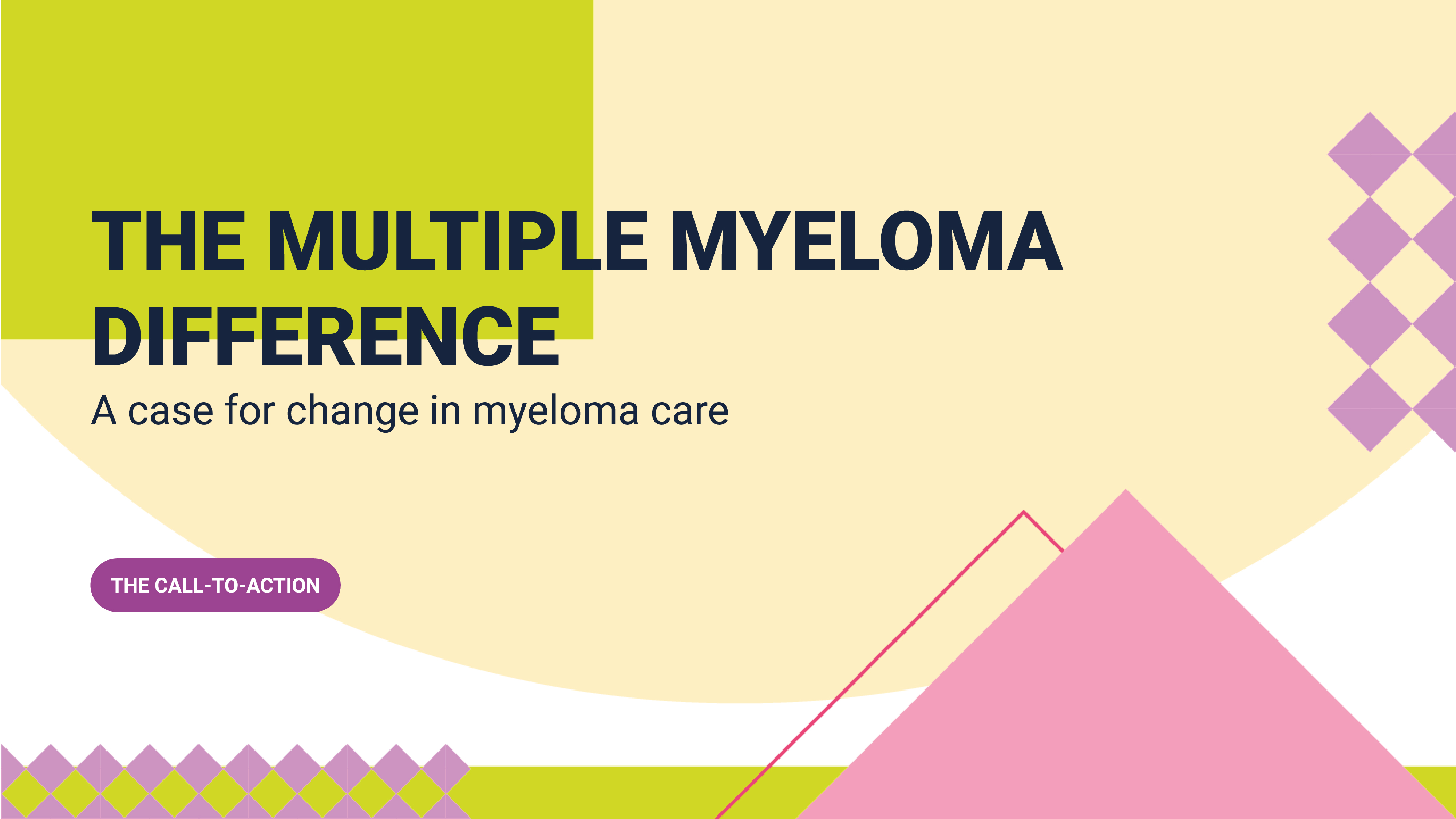We can change what a multiple myeloma diagnosis means – but only by working together

While Multiple myeloma (MM) is still an incurable disease today, there are reasons to be optimistic for the future.[1] What unites many of us working in the disease area is the ultimate goal of not just managing the condition, but curing it.[1] Thanks to major scientific advances in how the disease is treated and managed, we now see some patients go on to live for up to a decade or longer.[2],[3] And while we have yet to find a treatment that can cure the disease, each development takes us one step closer to reaching this ultimate ambition.[1]
Yet, relapse is still considered inevitable and the incidence of the disease is rising, with Western Europe among the worst affected regions. [4],[5] MM also continues to be associated with the lowest patient health-related quality of life (HRQOL) compared to other cancer survivors.[6] Symptoms such as severe fatigue, insomnia, pain and loss of appetite all impact the quality of their remaining years.[6]
We must do more to address these unmet needs and, as a leader in the field, Janssen is determined to be part of the solution. But to change the course of MM, we cannot work alone. This is why we have established the Global Multiple Myeloma Collaboration Council, which, for the first time, brings together a multidisciplinary team, featuring patient advocates, clinical leaders, researchers and policy experts from 10 countries across four continents. These experts, united by a commitment to improving MM care, came together to focus efforts at a global level and build momentum to advance patient care and outcomes.
The Council's first major public milestone arrived this month, with the release of its Call-To-Action, a report outlining the most critical unmet needs in MM care. It includes recommendations for how the medical community can advance patient outcomes all over the world. You can find the Call-To-Action report here – and I encourage you to read it and share it with your peers.
Here are their key areas for focus:
- Ensure timely diagnosis through increased education and awareness and faster referral
In a recent EU survey, nearly 25% of MM patients said they waited five months or more to be diagnosed. [7] They also receive, on average, three consultations prior to a specialist referral, higher than any other reported cancer. [8] These delays increase the risk of complications and have a negative impact on patient outcomes. [9],[10] By doing more to educate primary care professionals and the general public on the symptoms of MM, and by improving access to testing, we can ensure people are referred to specialist care more quickly and achieve better results for patients.9
- Build treatment consensus to help clinicians navigate complex decisions
Complex conditions like MM need individual solutions, which is why the advances in like CAR T-cell therapies, which use the patient’s own immune system to fight the cancer, are such a transformational move.[11] But having many choices also brings challenges. In a study of patients with relapsed/refractory MM, 92 unique treatment combinations were identified.[12] Even for specialists, this huge variety of options can be challenging to navigate. We must enhance our understanding of treatment response for individualised approaches. Generating data to guide optimal algorithms for more personalised treatment strategies could be accelerated by building consensus on the use of other surrogate end points, such as minimal residual disease (MRD) testing, and aligning on therapy goals.
- Improve relevance of clinical trials for clinical practice
Applying clinical trial findings in a real-world setting is a significant challenge in MM. Nearly 40% of patients do not meet the criteria for inclusion in Phase 3 studies. [13] In addition, people from lower income countries have a more limited access to trials. [14] Increasing diversity in trials and including practically relevant clinical trial populations more broadly should be a focus. In addition, increasing the priority of endpoints measuring patient experience and collecting complementary real-world data would help to better inform clinical practice.
- Holistic MM management addressing patient needs
People with MM require holistic care that is tailored to their individual needs – something that 97% of newly diagnosed patients rely on their caregivers to provide. [15] The physical, emotional and social burden of both the disease and its treatment often goes under-addressed. By ensuring patients have access to multidisciplinary care teams and by prioritising shared decision-making in clinical practice, we can more consistently meet their needs throughout their MM journey.
These four focus areas are just the beginning. What links them – and what will continue to define the Council's work in future – takes us back to where we started: Collaboration. Real, lasting change in how we diagnose, treat and manage this disease relies on every part of the MM community working in partnership and inspiring each other towards common goals.
Through identifying the four key areas of unmet need, we can collectively focus our efforts for patients living with MM. From increased awareness in non-specialist healthcare professionals and continued investment in treatment innovation, to the generation of highly relevant data to guide complex treatment decisions, and better understanding of the patient needs at each stage of the MM journey. This is just a snapshot of what is needed, but together, I am confident we can drive change.
It excites me to think that we might reach a point in my professional lifetime where we can not only make it easier for MM patients to manage their disease, but actually provide them with a functional cure. That, ultimately, is the future of MM care we all want. Together, we can create it.
[1] International Myeloma Foundation (IMF). Road to the Cure: The IMF Leading the Charge. Accessed May 2023. Available at: https://www.myeloma.org/black-swan-research-initiative/road-cure
[2] Hemminki K et al. Survival trends in hematological malignancies in the Nordic countries through 50 years. Blood Cancer Journal. 2022;12(150).
[3] Eisfeld C et al. Time trends in survival and causes of death in multiple myeloma: a population-based study from Germany. BMC Cancer. 2023; 23(317).
[4] Podar K & Leleu X. Relapsed/Refractory Multiple Myeloma in 2020/2021 and Beyond. Cancers (Basel). 2021;13(20):5154
[5] Cowan, AJ et al. A systematic analysis for the Global Burden of Disease Study 2016. JAMA Oncology. 2018;4:1221-1227.
[6] O’Donnell EK et al. Quality of life, psychological distress, and prognostic perceptions in patients with multiple myeloma. Cancer. 2022;128(10):1996-2004
[7] Koshiaris, C., et al., Quantifying intervals to diagnosis in myeloma: a systematic review and meta-analysis. BMJ Open, 2018. 8(6): p. e019758.
[8] Lyratzopoulos G et al. Variation in number of general practitioner consultations before hospital referral for cancer: findings from the 2010 National Cancer Patient Experience Survey in England. Lancet Oncol. 2012;13:353-365.
[9] Kariyawasan CC et al. MM: causes and consequences of delay in diagnosis. QJM. 2007;100:635-640.
[10] Gao S et al. Clinical characteristics and survival outcomes of newly diagnosed MM patients presenting with extramedullary disease: A retrospective study. Leuk Res. 2022;115:106793.
[11] Rendo et al. CAR T-cell therapy for patients with multiple myeloma: current evidence and challenges. Blood Lymphat Cancer. 2022;12:119-136.
[12] Mateos, M.V., et al., LocoMMotion: a prospective, non-interventional, multinational study of real-life current standards of care in patients with relapsed and/or refractory multiple myeloma. Leukemia, 2022. 36(5): p. 1371-1376.
[13] Terpos E et al. Management of patients with MM beyond the clinical-trial setting: understanding the balance between efficacy, safety and tolerability, and quality of life. Blood Cancer J. 2021;11:40.
[14] Fatoki RA et al. Global Myeloma Trial Participation and Drug Access in the Era of Novel Therapies. JCO Glob Oncol. 2022;8:e2200119
[15] Gatopoulou, X., et al., The Burden of a Multiple Myeloma Diagnosis on Patients and Caregivers in the First Year: Western European Findings. Clinicoecon Outcomes Res, 2022. 14: p. 731-753.



